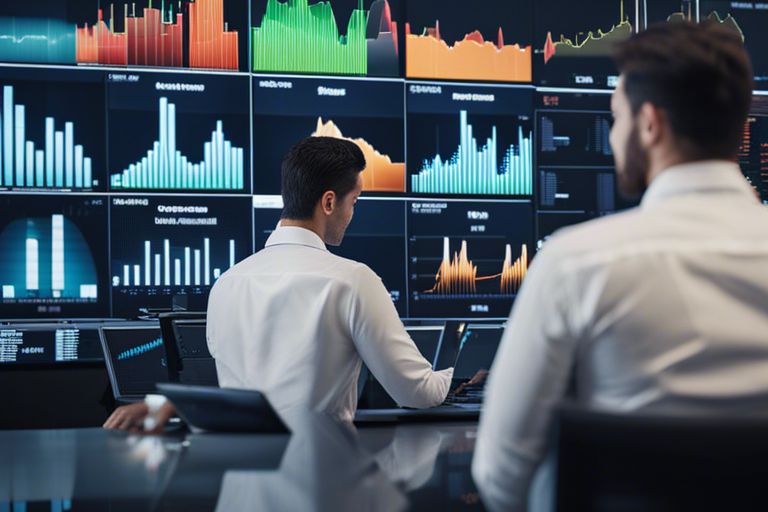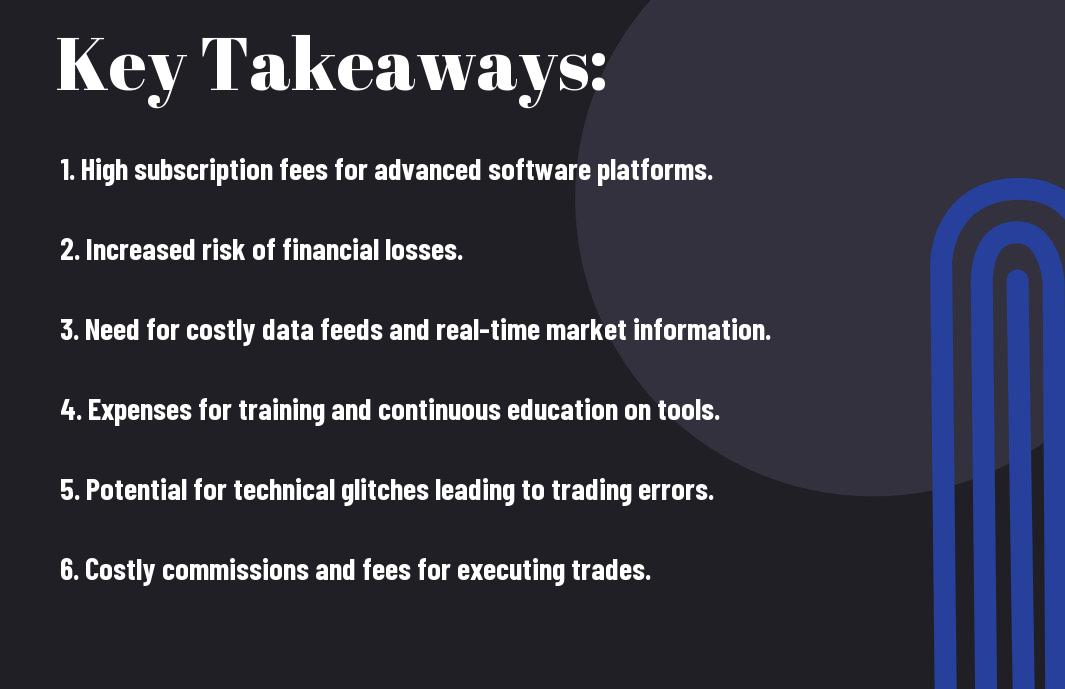There’s a world of possibilities when it comes to using Advanced Trading Tools and Features, but have you considered the costs that come with them? By delving into advanced market trading tools, you open yourself up to a range of expenses that can impact your overall trading strategy. From subscription fees and commissions to potential data fees and platform costs, understanding the full scope of expenses is crucial in making informed decisions about utilizing these powerful tools in your trading endeavors.
Key Takeaways:
- Initial Investment: Advanced market trading tools often require a significant upfront cost to purchase and implement.
- Subscription Fees: Many advanced market trading tools come with monthly or annual subscription fees, adding to the ongoing costs of using these tools.
- Training and Support: Users may need to invest time and resources in training and support to fully utilize the capabilities of advanced market trading tools.

Types of Advanced Market Trading Tools
While using advanced market trading tools, it’s necessary to understand the different types available to investors.
- Algorithmic Trading Platforms
- High-Frequency Trading Systems
- Artificial Intelligence-Based Trading Tools
Algorithmic Trading Platforms
Trading through algorithmic platforms involves using computer programs to execute trading strategies automatically. These platforms are programmed to follow specific instructions, such as timing, price, and quantity, to make trades on your behalf.
| Pros | Cons |
| Provides rapid order placement | Requires advanced programming knowledge |
| Executes trades at best possible prices | Subject to technical glitches or system failures |
| Minimizes emotional trading decisions | May not adapt well to sudden market changes |
High-Frequency Trading Systems
Any trading system that uses powerful computers to transact a large number of orders at extremely high speeds falls under high-frequency trading. These systems can analyze market data and execute trades within milliseconds, taking advantage of small price discrepancies in the market.
Market conditions and regulatory changes can significantly impact the effectiveness of high-frequency trading systems. They require substantial initial investments in technology and infrastructure to gain a competitive edge and may face increased scrutiny due to their rapid trading nature.
Artificial Intelligence-Based Trading Tools
Types of AI-based trading tools utilize machine learning algorithms to analyze vast amounts of data and identify potential trading opportunities. These tools can adapt to changing market conditions and make predictions based on historical patterns and real-time information.
This advanced technology can enhance trading efficiency and potentially improve trading outcomes by identifying trends or anomalies that human traders might overlook. However, the effectiveness of AI-based tools heavily relies on the quality of data inputs and the complexity of algorithms used.

Direct Costs
Assuming you are considering using advanced market trading tools, it’s important to be aware of the direct costs associated with these tools. These costs can vary depending on the type of tool and the provider you choose.
Subscription Fees
One direct cost you may encounter is subscription fees. Many advanced market trading tools require a subscription for access to their features and analysis. These fees can range from monthly to annual payments, and the cost can add up over time. It’s imperative to factor in these recurring expenses when considering the overall cost of using these tools.
Licensing Fees
Subscription-based tools may also come with licensing fees, which grant you the right to use the software for a specific period. These fees are typically one-time payments, but they can be significant, especially for tools with advanced capabilities. To make an informed decision, consider the licensing fees along with the subscription costs to determine the total investment required.
To help manage licensing fees, some providers offer tiered pricing plans based on the features you need. It’s imperative to assess your trading requirements to select a package that aligns with your goals and budget.
Maintenance and Support Costs
On top of subscription and licensing fees, you should also consider maintenance and support costs. These expenses cover updates, technical assistance, and troubleshooting to ensure the smooth operation of the trading tools. While these costs may seem secondary, they are crucial for ongoing usability and performance of the tools.
Support services can vary in quality and responsiveness among providers. Opting for a provider with robust support can save you time and frustration when facing technical issues or needing guidance on using the advanced features effectively.
Indirect Costs
Many Low fees. Powerful trading. associated with using advanced market trading tools go beyond just the direct fees you may see. These indirect costs can add up and impact your overall investment outcomes. Here are some indirect costs to consider:
Infrastructure and Hardware Expenses
Expenses related to infrastructure and hardware can be significant when using advanced trading tools. Investing in high-speed internet, powerful computers, and backup systems is necessary for executing trades efficiently and securely. Additionally, you may need to consider costs for maintaining and upgrading these systems regularly to ensure optimal performance.
Data Feed and API Costs
Costs associated with accessing real-time market data feeds and APIs can also add to your overall expenses when using advanced trading tools. These costs can vary depending on the frequency and depth of the data you require. Subscribing to premium data services or API access can provide you with a competitive edge but at an additional cost.
To effectively leverage advanced market trading tools, you must have reliable data sources and seamless API connections. While these services enhance your trading capabilities, they come with a price tag that you need to consider when calculating your overall trading costs.
Training and Education Expenses
An necessary but often overlooked aspect of using advanced market trading tools is investing in your training and education. Understanding complex trading algorithms, technical analysis tools, and risk management strategies requires time and effort. You may need to enroll in courses, attend workshops, or hire a mentor to deepen your knowledge and skills in utilizing these tools effectively.
Costs associated with training and education are investments in your long-term success as a trader. By continuously improving your knowledge and skills, you can make informed decisions and adapt to the dynamic nature of the financial markets effectively.

Hidden Costs
Once again, while advanced market trading tools can offer numerous benefits, there are also hidden costs that you need to be aware of. These costs may not be as obvious as commission fees or subscription charges, but they can still impact your overall trading experience and financial outcomes.
Opportunity Costs of Over-Reliance on Technology
To maximize your trading success, it’s crucial to strike a balance between leveraging advanced tools and maintaining a clear understanding of market dynamics. Over-relying on technology can lead to missed opportunities or delayed decision-making, as you may become detached from the fundamental aspects of trading. Keep in mind, markets are influenced by various factors, and being overly dependent on automated systems may hinder your ability to adapt swiftly to changes and capitalize on emerging trends.
Risks of Over-Trading and Market Volatility
Volatility in financial markets is a common occurrence, and over-trading due to excessive use of advanced tools can amplify the risks associated with market fluctuations. When you engage in frequent trades driven solely by technology-generated signals, you may expose yourself to increased market volatility and potential financial losses. It’s necessary to exercise caution and not let the speed and convenience of trading platforms lure you into making impulsive decisions that could jeopardize your investment portfolio.
Costs
Compliance and Regulatory Costs
Market regulations are designed to ensure fairness, transparency, and investor protection. However, using advanced market trading tools may increase your exposure to compliance and regulatory costs. As technology evolves, regulators continuously adapt rules to address new trading practices and safeguard the integrity of the financial system. Failing to comply with these regulations can result in penalties, legal repercussions, or restrictions on your trading activities, which could ultimately outweigh the benefits of advanced tools if not managed effectively.
Understanding these hidden costs associated with advanced market trading tools is necessary for making informed decisions and optimizing your trading strategies. By maintaining a holistic perspective on the potential drawbacks and expenses involved, you can navigate the complexities of the financial markets more effectively and enhance your long-term trading performance.
Costs Associated with Data Quality
All advanced market trading tools rely heavily on high-quality data to make informed decisions and generate accurate insights. This data comes at a cost, not only in terms of monetary expenses but also in terms of the resources required to acquire, integrate, store, manage, analyze, and visualize it effectively.
Data Acquisition and Integration Costs
Any data-driven trading strategy starts with sourcing and integrating data from various providers. This process can be time-consuming and requires specialized skills to ensure data accuracy and consistency. Moreover, integrating data from multiple sources often involves additional costs, such as subscription fees or licensing fees.
Data Storage and Management Expenses
The storage and management of large volumes of market data can be another significant cost associated with using advanced trading tools. This includes expenses related to maintaining servers, cloud storage services, data warehouses, and other infrastructure needed to store and manage data securely. Ensuring data security and compliance with regulations also adds to these expenses.
The efficiency of your data storage and management practices can impact the performance and scalability of your trading tools. This is why investing in robust data storage solutions and implementing efficient data management processes is crucial for optimizing the costs associated with data quality.
Data Analytics and Visualization Costs
This aspect of data quality costs is related to the tools and technologies used to analyze and visualize market data. Advanced analytics tools, machine learning algorithms, and visualization software often come with licensing fees or subscription costs. Additionally, training personnel to use these tools effectively can also be a significant expense.
Any delays or inaccuracies in data analytics and visualization can impact your trading decisions and results. Therefore, investing in the right tools and technologies, along with proper training for your team, is crucial to ensure the quality and accuracy of your data analysis and visualization processes.
Storage costs can vary depending on the type and volume of data you need to store. Cloud storage solutions offer scalability and flexibility but come with monthly fees based on usage. On the other hand, setting up and maintaining an on-premise data warehouse can involve higher initial costs but may be more cost-effective in the long run for larger datasets.
Costs of Human Capital
Hiring and Training Traders and Analysts
Analysts play a crucial role in utilizing advanced market trading tools effectively. Hiring and training these professionals can be a significant cost for your organization. Finding skilled traders and analysts who understand the complexities of the financial markets and can leverage the advanced tools at their disposal requires a substantial investment of time and resources.
Salaries and Benefits for IT and Support Staff
Support staff and IT professionals are necessary for ensuring the smooth operation of advanced market trading tools. These individuals handle the technical aspects of the tools, troubleshoot any issues that arise, and provide support to traders and analysts. Salaries and benefits for IT and support staff can represent a sizable portion of your overall costs when using advanced trading tools.
Furthermore, providing competitive salaries and attractive benefits to retain top IT and support talent is crucial in this competitive industry. Investing in your IT and support staff ensures that your advanced market trading tools operate efficiently and effectively, ultimately contributing to the success of your trading strategies.
Consulting and Outsourcing Fees
Any organization using advanced market trading tools may incur consulting and outsourcing fees. These costs can come from external consultants who provide expertise in implementing, optimizing, or customizing the trading tools. Outsourcing certain functions, such as data analysis or software development, can also lead to additional expenses.
It is necessary to carefully evaluate the benefits of consulting and outsourcing services against the associated costs. While these services can provide valuable expertise and support, they can also contribute to the overall expenses of utilizing advanced market trading tools.
Training
Training your traders and analysts to effectively use advanced market trading tools is crucial for maximizing the tools’ potential and ensuring accurate decision-making. Investing in ongoing training programs can also aid in keeping your team up-to-date with the latest trends and technologies in the financial markets, ultimately enhancing your organization’s competitive edge.
Final Words
Presently, you should have a better understanding of the costs associated with using advanced market trading tools. While these tools can provide you with valuable insights and help enhance your trading strategies, it’s crucial to consider the financial aspects involved. Be mindful of the subscription fees, data fees, and potential costs of making trades through these platforms. By carefully weighing the benefits and costs, you can make informed decisions on whether these tools are worth incorporating into your trading routine.
Q: What are the costs associated with using advanced market trading tools?
A: The costs associated with using advanced market trading tools can vary depending on the platform or software you choose. Some common costs to consider include:
- Subscription fees: Many advanced trading tools require a subscription fee to access their platform and features. These fees can range from a monthly to an annual basis.
- Commission fees: Some platforms charge commission fees for each trade executed using their tools. These fees are generally a percentage of the trade value.
- Data fees: Real-time market data and research tools may come at an additional cost. These fees are typically charged by data providers and can add to the overall expense of using advanced trading tools.
Q: Are there any hidden costs associated with using advanced market trading tools?
A: While most platforms are transparent about their fees, there can be hidden costs associated with using advanced market trading tools. Some potential hidden costs to watch out for include:
- Inactivity fees: Some platforms may charge inactivity fees if you do not use the trading tools for a certain period of time. Be sure to check the platform’s terms and conditions to avoid any unexpected charges.
- Advanced features fees: Certain advanced trading tools may offer additional features or services that come at an extra cost. Make sure to review the platform’s pricing structure to understand what is included in your subscription.
- Transaction fees: While commission fees are common, some platforms may also charge additional transaction fees for specific types of trades or transactions. It’s important to be aware of all potential fees before using advanced trading tools.
Q: How can I minimize the costs associated with using advanced market trading tools?
A: To minimize costs when using advanced market trading tools, consider the following tips:
- Compare pricing: Research and compare the subscription fees, commission rates, and data fees of different platforms to find the most cost-effective option for your trading needs.
- Utilize free trials: Take advantage of free trials offered by trading platforms to test out their tools and features before committing to a subscription.
- Avoid unnecessary features: Be selective about the advanced features and services you require, as additional features often come with extra costs. Focus on the tools that are necessary for your trading strategy to keep costs down.
